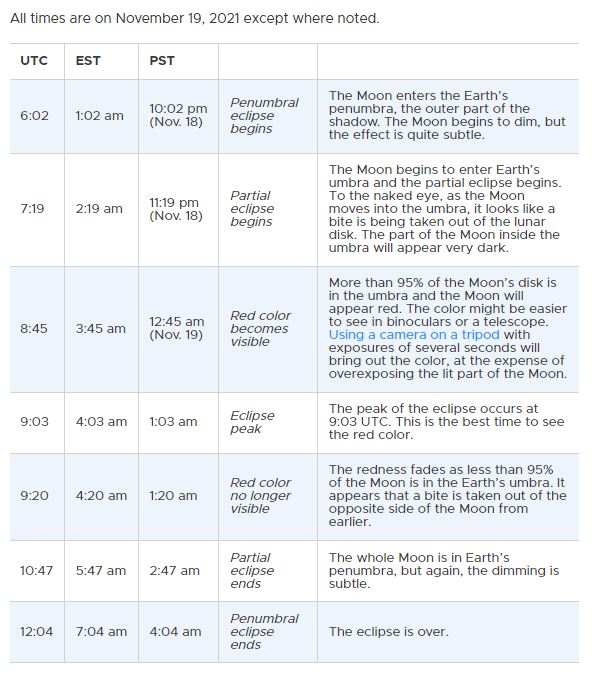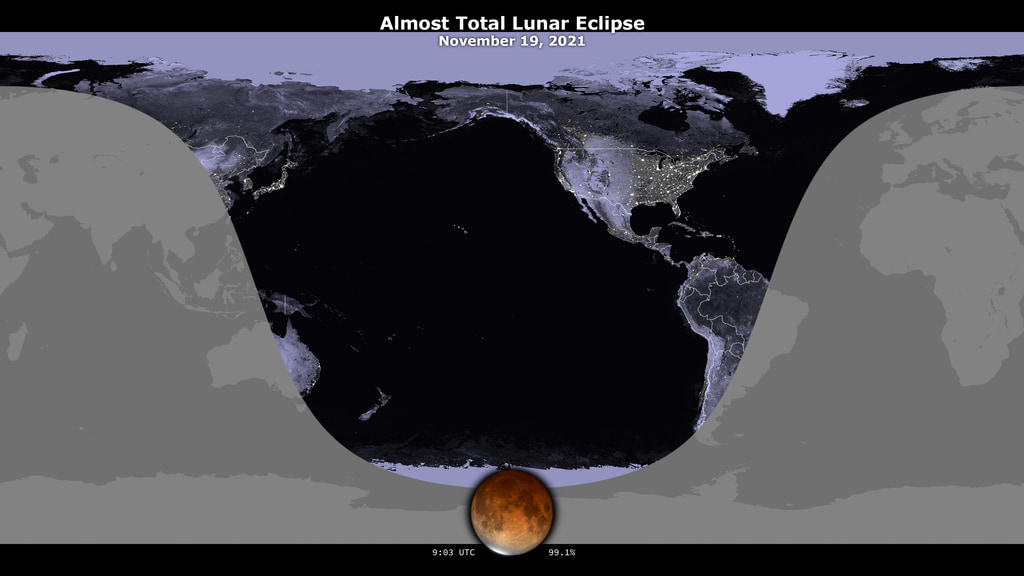Lunar Eclipse Friday Morning
Top Stories
18 Nov 2021 8:00 PM
Set your alarms now, the frost moon will be tuning red on Friday morning! You'll have to stay up late, or get up early, but the moon will be putting on a show for all of North America during the pre-dawn hours of November 17th, with the peak around 4:00 am EST.
https://youtu.be/9EOy6uX6Gm4

 Image credit: NASA's Scientific Visualization Studio
Timing for this lunar eclipse will be great for all of the the North American continent. Those farther east will have to look toward the western horizon, so if your view to the west is blocked by trees or terrain, you may have to move a bit to catch the red color during the greatest extent.
The moon should be high enough in the sky for Mountain and Pacific time zones to see without issue.
The NASA graphic above shows where the eclipse is visible (areas not in the shaded region).
Image credit: NASA's Scientific Visualization Studio
Timing for this lunar eclipse will be great for all of the the North American continent. Those farther east will have to look toward the western horizon, so if your view to the west is blocked by trees or terrain, you may have to move a bit to catch the red color during the greatest extent.
The moon should be high enough in the sky for Mountain and Pacific time zones to see without issue.
The NASA graphic above shows where the eclipse is visible (areas not in the shaded region).
Almost total eclipse
[embed]https://moon.nasa.gov/system/video_items/117_eclipse_202111_umbra_1080p30.mp4[/embed] Video credit: NASA's Scientific Visualization Studio This eclipse will not be a "total" eclipse, but it will be very close. During a lunar eclipse, the moon passes through one or two sections of earth's shadow, called the penumbra and the umbra. During a total eclipse, the moon is completely covered by the darkest portion of the shadow, the umbra. This Friday, around 99.1% of the Moon will be within Earth’s umbra, leaving all but a tiny sliver covered. Even though it won't be a total eclipse, the familiar red hue created by the umbra should still be visible around the lead up to the peak.When to Watch
Unless you have 6 hours to kill, you'll probably just want to watch around the time of totality. On the East Coast, expect the greatest extend of the eclipse to occur just after 4:00 am, while on the West Coast, this will occur just after 1:00 am. NASA posted the following table of times for the event, which you can access here.
Where to look:
 Image credit: NASA's Scientific Visualization Studio
Timing for this lunar eclipse will be great for all of the the North American continent. Those farther east will have to look toward the western horizon, so if your view to the west is blocked by trees or terrain, you may have to move a bit to catch the red color during the greatest extent.
The moon should be high enough in the sky for Mountain and Pacific time zones to see without issue.
The NASA graphic above shows where the eclipse is visible (areas not in the shaded region).
Image credit: NASA's Scientific Visualization Studio
Timing for this lunar eclipse will be great for all of the the North American continent. Those farther east will have to look toward the western horizon, so if your view to the west is blocked by trees or terrain, you may have to move a bit to catch the red color during the greatest extent.
The moon should be high enough in the sky for Mountain and Pacific time zones to see without issue.
The NASA graphic above shows where the eclipse is visible (areas not in the shaded region).
How to Photograph
Your phone may not be the best option, since a digital zoom will lower the quality of the photo on most phones. If you don't have an optical zoom, use your phone's night mode. If you have a camera with manual settings, taking an exposure several seconds long will help bring out the red color of the eclipse, though it will wash out the sliver of the moon that will still be uncovered. Use a tripod or find an object that will steady your camera, bring the ISO up to 800 or higher, and shoot! Depending on the amount of the moon covered, you may need to extend the exposure period.All Weather News
More